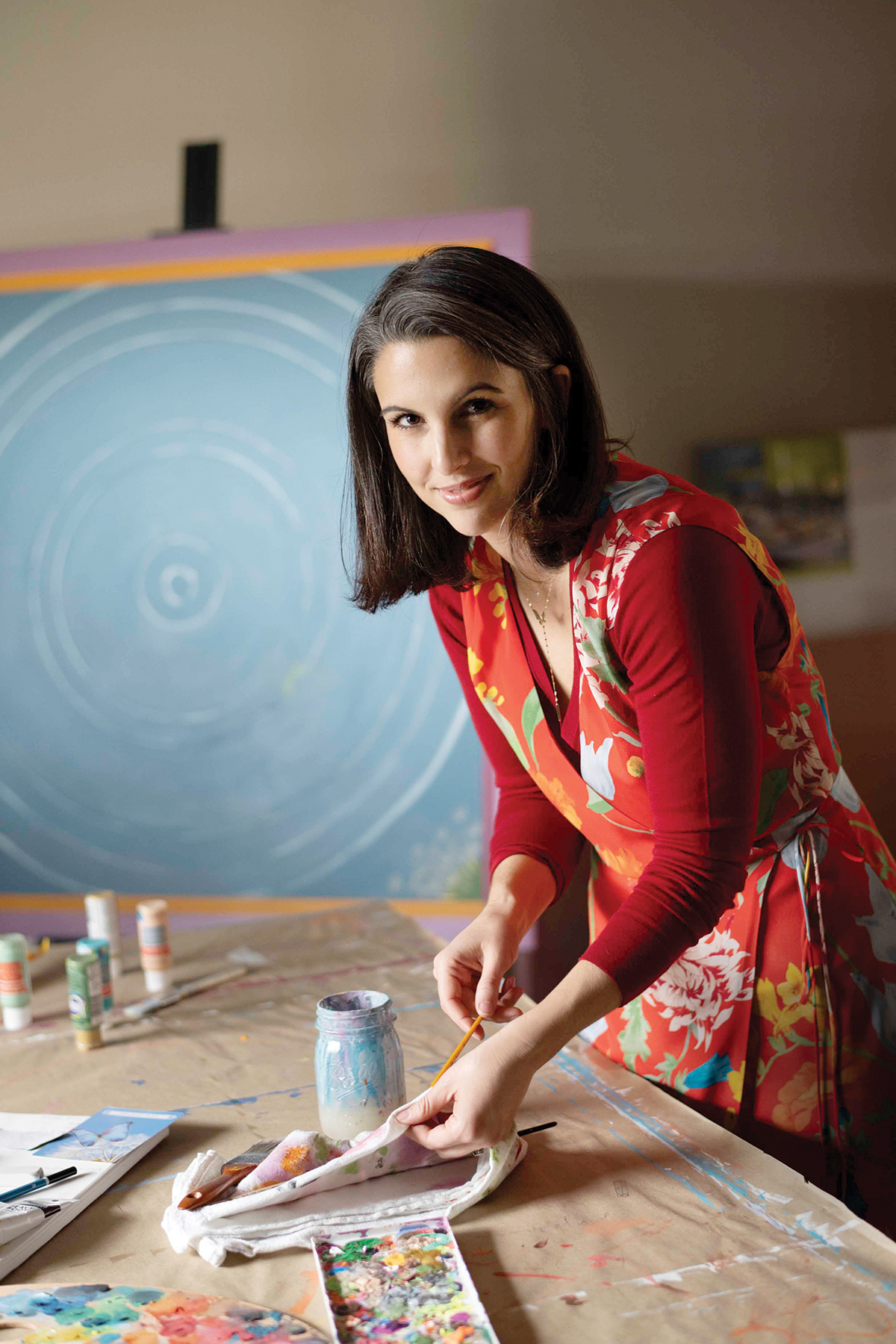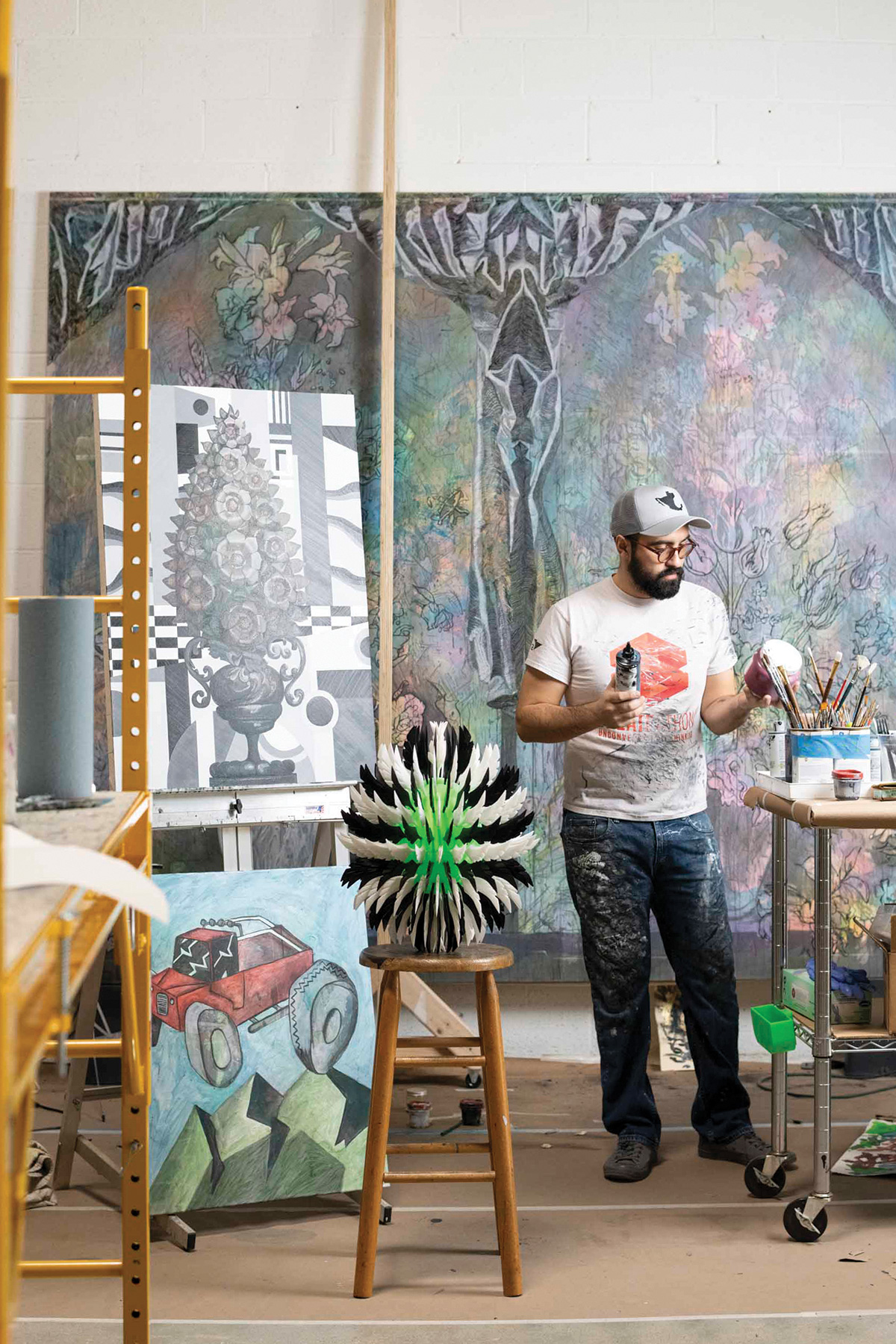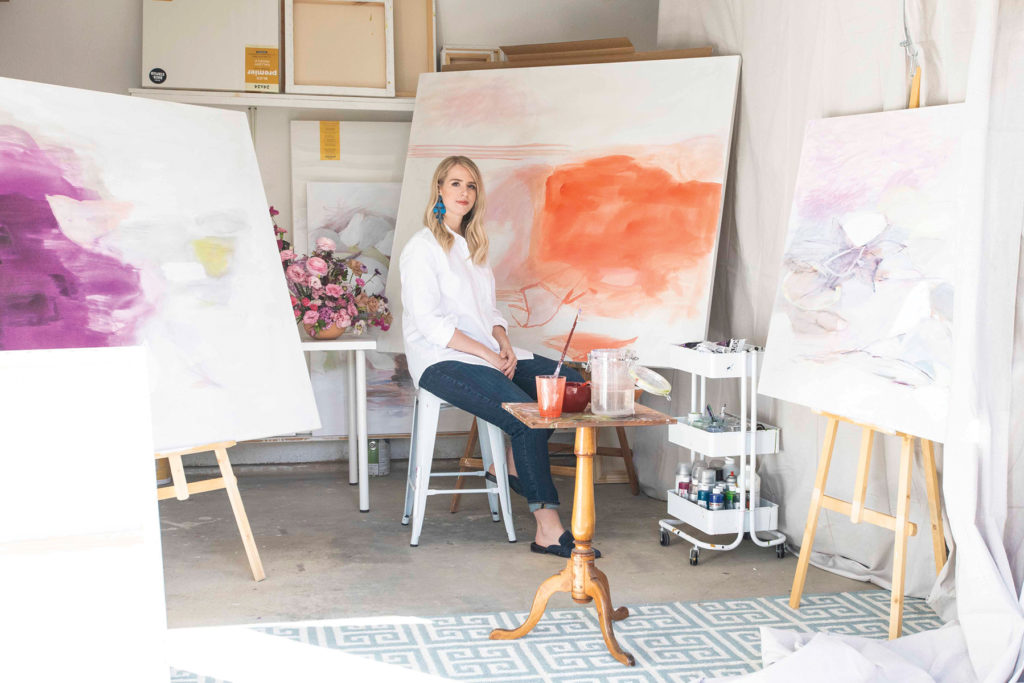Asking an Artist What Kind of Art Do They Do
Having a piece of artwork commissioned can be a rewarding source of joy for art lovers. But for first-time clients, the procedure tin be total of questions and unknowns. How much will information technology cost? How long will information technology take? How much say will I have in the final production? Though each creative person'due south method is different, these experts help peel away some of the mystery.
The Creative person
When budgeted an artist , remember each i's procedure is unlike. But the end goal is the same: "Everyone deserves to take an original piece in their home," says creative person Corinne Bizzle. "I want the customer to be heard, and I try and transform that into a painting." Creative person Taelor Fisher starts with size, colour palette, timeline, and mode when working with a customer. Then, she creates mini drafts for blessing. But she also loves when clients give her the freedom to create. "Every artist puts their heart and soul in the process," she says. "We desire you to dearest it."

Artist Mione Plant probes prospective clients near existing works they like and why. She will provide preliminary sketches if requested and recommends asking if such sketches and subsequent edits are included in the cost. "Those sketches take fourth dimension," she says. "Information technology may not accept the finishing touches, merely some do charge for that time."
Arienne Lepretre prefers to invite clients to her studio so they can run across her range of work and visualize what they want. She recommends request about the artist'southward timeline. "Sometimes I'm decorated getting a show ready," says Lepretre, who as well leaves a few days between finishing the work and handing it over. "I don't paint these paintings; they paint themselves and let me know when they're done."
Artists like Francisco Moreno and Zeke Williams, whose bread and butter is not commission work, are choosier when taking on projects. "I only exercise commissions if I trust the person asking me and if the project fits in line with my interests," Moreno says. He will provide the client with a digital mock-up created with 3D modeling and Photoshop. Equally e'er, the main primal is communication: "Know what you want and express it," Williams says.

Merely some artists like Allen Kirsch, who works directly through the Holly Hunt showroom, agree on a color palette and so affirm complete independence. "The client needs to be completely open to the artist's vision," he says.
The Client
How exercise you know if the committee is process for you? Client Laurel Stasey made the jump when she couldn't observe the right slice for a nursery. "Commercial prints felt mundane or close but not quite correct," she says. Calibration can be another motivator, equally it was for Emily Feldman and her married man, whose large entryway proved a challenge to adequately make full. "You don't ever find what you want out there, or the scale might be too big for the room," Feldman says.
Once you decide to commission, explore artists' websites, galleries, and Instagram accounts. Feldman found creative person Taelor Fisher through her designer Mikee Smythe. Fisher visited the Feldmans' dwelling to run across the space and learn the client's sense of taste. "She had a vision right when she walked in," Feldman says. "I dearest the idea that there's office of my thoughts behind it."

Merely don't be agape to trust the creative person. "I trusted Mione [Plant]'s instincts and didn't desire to stifle her inventiveness," says Stasey, who had provided Plant with the theme of "spring" and pictures of her husband's family ranch for inspiration. Plant plant a photograph on Stasey's Instagram of a cactus from the ranch that blooms once a year. Plant then created a painting of 365 identical cacti, with but one in full bloom to correspond the child's birthday. She enclosed a annotation to the then-unborn baby explaining the thought that "some things are absolutely worth waiting for." Says Stasey, "Letting her create without parameters allowed for the well-nigh extraordinary surprise."
The Designer
"My chore is to educate [the client] on what'south out there," designer Abbe Fenimore says. "Art is so personal."
When helping to facilitate a project, designers accept many factors into consideration. Mikee Smythe, for example, minored in art in college, then she has a detail understanding of its importance in the abode. "Art should be something you connect to—that happens in commissioned work," she says. She considers not only calibration and subject field affair, but also the medium or particular brushstrokes when pairing a client with an artist. "For case, you tin apply a palette-knife slice in a space where art needs to hold its ain," she says. Personality fit of the artist and client likewise plays into it: "That affects the quality of the product you're going to get."
Christopher Huffman, gallery managing director at Maestri Gallery, likes to starting time with size when a client is pursuing a deputed piece. "Then we facilitate communication between the client and the artist," he says. They start with a site visit for the creative person to the client's abode and follow up with progress photos once the artist begins work.
Designer Sarah Hargrave of The Commonage often does a fabric presentation with the artist so he or she sees the materials and colors used in the dwelling. She arranges for the artist to visit the home in person to observe its natural calorie-free and other factors. Many of the artists she works with will present a concept on paper for the client'southward review. At that betoken, the customer is free to give feedback. "The customer picked out some colors she didn't want," says Hargrave of i recent project. "We got to the final conclusion based on the original. We spent a little more fourth dimension, just it worked in the end."
Happy Mediums
What to remember when hiring an artist
Keep your mind open. "Be open to suggestions and ideas, simply if an artist wants your feedback, definitely tell them your thoughts," says client Emily Feldman.
Don't be afraid to permit get. "Y'all have to let become and let people do what they're skilful at," says designer Abbe Fenimore. "You were attracted to their work for a reason."
Expect to pay almost a 50 percent deposit on your slice. "Get the artist to tell y'all up front what the price is," Fenimore says.
Know that the level of detail will affect price. "Some [piece of work] is really labor intensive and some is not. It depends on the medium," says designer Sarah Hargrave.
Don't go matchy-matchy. "Deputed pieces are great for helping a client break gratuitous from self-inflicted rules that fine art tends to abide past," says designer Mikee Smythe.
Enquire the artist for his or her markup percentage. Some don't marking up commissions at all or only have a 10 percent increase. "Art doesn't have to break the depository financial institution," says Smythe.
Each example is different, but expect about an eight- to 12-week product process. "Set up open communication with the creative person," says gallery manager Christopher Huffman.
Source: https://www.dmagazine.com/publications/d-home/2019/march-april/how-to-commission-an-artist/
0 Response to "Asking an Artist What Kind of Art Do They Do"
Post a Comment